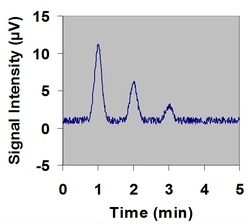Signal-to-Noise Enhancement
- Page ID
- 77474
As the S/N of an analytical signal decreases, so does the accuracy and precision of that signal. The pair of plots below illustrate this point. The plot to the left contains three analyte peaks with a peak-to-peak noise level of 0.19 μV. The S/N for each peak is 52, 26, and 10 respectively. Increasing the peak-to-peak noise level ten-fold (1.9 μV) decreases the S/N of each peak by a factor of ten. (5.2, 2.6, 1.0 respectively)


Note that the signal at 2 minutes, with a S/N ratio of ~3, is at a level commonly known as the detection limit, which is defined as the magnitude at which the signal is statistically distinguishable from the noise. The signal at 3 minutes, which has a S/N equal to 1, is indistinguishable from the baseline noise. This comparison illustrates the need to reduce noise to a level at which chemical information is not compromised. A spreadsheet has been designed to illustrate the relationship between signal and noise. Click here to perform these exercises.
Can Noise be Reduced After the Data has been Recorded?
In the examples above, the frequency of the signal is less than the frequency of the noise. In all cases, if the signal frequency and the noise frequency are not equal, then there should be at least one suitable approach to noise reduction.
Overview of S-N Enhancement Techniques
This module will describe two general categories of noise reduction techniques:
- Analog Filtering (Hardware-Based)
- Digital Filtering (Software-Based)
Most of these S/N enhancement methods, whether analog or digital, are based on either:
- Bandwidth Reduction (i.e. decreasing Δf).
- Signal Averaging (i.e. decreasing Δf or averaging out random noise fluctuations)
Bandwidth reduction is important --- Remember, if fsignal ≠ fnoise, we have a chance of isolating the signal from the noise. This results in an enhanced signal-to-noise ratio and more reliable information about the chemical sample of interest. We will see that there are limitations to how much bandwidth reduction can be applied before distorting the instrumental signal. Nevertheless, these can be effective approaches to improving the quality of the instrumental signal.


